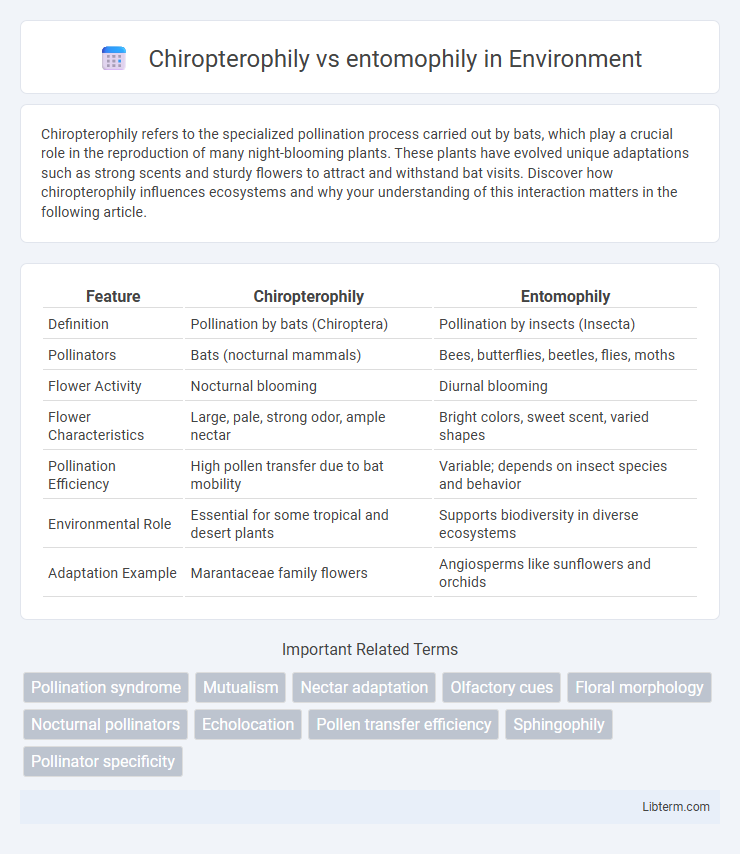Chiropterophily refers to the specialized pollination process carried out by bats, which play a crucial role in the reproduction of many night-blooming plants. These plants have evolved unique adaptations such as strong scents and sturdy flowers to attract and withstand bat visits. Discover how chiropterophily influences ecosystems and why your understanding of this interaction matters in the following article.
Table of Comparison
| Feature | Chiropterophily | Entomophily |
|---|---|---|
| Definition | Pollination by bats (Chiroptera) | Pollination by insects (Insecta) |
| Pollinators | Bats (nocturnal mammals) | Bees, butterflies, beetles, flies, moths |
| Flower Activity | Nocturnal blooming | Diurnal blooming |
| Flower Characteristics | Large, pale, strong odor, ample nectar | Bright colors, sweet scent, varied shapes |
| Pollination Efficiency | High pollen transfer due to bat mobility | Variable; depends on insect species and behavior |
| Environmental Role | Essential for some tropical and desert plants | Supports biodiversity in diverse ecosystems |
| Adaptation Example | Marantaceae family flowers | Angiosperms like sunflowers and orchids |
Introduction to Chiropterophily and Entomophily
Chiropterophily refers to pollination primarily facilitated by bats, which are attracted to large, nocturnal, and strongly scented flowers rich in nectar. Entomophily involves pollination by insects such as bees, butterflies, and beetles, favoring brightly colored, fragrant flowers that offer pollen and nectar as rewards. Both pollination strategies play crucial roles in ecosystem biodiversity and plant reproduction by catering to specific pollinator behaviors and adaptations.
Defining Chiropterophily: Bat Pollination Explained
Chiropterophily refers to pollination carried out by bats, which are attracted to flowers with strong odors, large quantities of nectar, and robust structures to support their weight. This type of pollination is crucial for the reproduction of several tropical and night-blooming plants, including agave and durian species. Unlike entomophily, which involves insect pollinators like bees and butterflies, chiropterophily ensures effective pollen transfer during nighttime when bats are active.
Understanding Entomophily: Insect Pollination Overview
Entomophily refers to pollination primarily facilitated by insects such as bees, butterflies, moths, beetles, and flies, which transfer pollen as they forage for nectar and pollen. This pollination strategy is critical for the reproduction of approximately 80% of flowering plants, ensuring genetic diversity and ecosystem stability. In contrast, chiropterophily involves pollination by bats, typically in nocturnal and tropical environments, offering a specialized method of pollen transfer for flowers adapted to attract these mammals.
Key Floral Adaptations for Bat Pollination
Chiropterophily, or bat pollination, involves floral adaptations such as large, sturdy flowers with robust petals to withstand bat visits, nocturnal blooming synchronized with bat activity, and strong, musky odors to attract bats. These flowers typically produce abundant, dilute nectar accessible to bats' long tongues and emit pale or white colors to enhance visibility in low light. In contrast to entomophily (insect pollination), which often relies on bright colors and sweet fragrances to attract insects, bat-pollinated flowers emphasize durability and sensory cues suited for echolocating and visually limited bats.
Characteristic Plant Traits for Insect Pollinators
Insect-pollinated plants, or those exhibiting entomophily, often possess bright, colorful flowers with distinct patterns and emit strong, sweet fragrances to attract pollinators such as bees, butterflies, and beetles. These flowers typically exhibit nectar guides, UV patterns, and accessible nectar rewards tailored to insect morphology and foraging behavior. In contrast to bat-pollinated plants, entomophilous species tend to have smaller, more intricate floral structures optimized for insect landing and probing.
Ecological Roles: Bats vs. Insects in Pollination Networks
Bats serve as key nocturnal pollinators in tropical ecosystems, facilitating gene flow for plants like agave and durian through chiropterophily, thus sustaining biodiversity and fruit production. Insects, primarily bees and moths, dominate entomophily by supporting a wider variety of angiosperms during daylight, enhancing ecosystem resilience and agricultural yields. Their complementary roles ensure continuous pollination services, maintaining complex plant-pollinator networks critical for ecosystem functioning.
Evolutionary Drivers Behind Pollination Strategies
Chiropterophily and entomophily represent specialized pollination strategies driven by evolutionary pressures such as resource availability, predator avoidance, and reproductive efficiency. Chiropterophily, pollination by bats, evolved in night-flowering plants with sturdy, often large flowers and abundant nectar to attract nocturnal pollinators, ensuring effective pollen transfer over long distances in habitats where insect activity is low. In contrast, entomophily relies on diverse insect pollinators with adaptations favoring colorful petals, scents, and nectar guides, reflecting co-evolution with insect sensory and foraging behaviors that optimize pollen dispersal in diurnal ecosystems.
Geographic Distribution and Habitat Preferences
Chiropterophily, or bat pollination, primarily occurs in tropical and subtropical regions where nocturnal flowering plants thrive, favoring habitats such as rainforests, caves, and desert oases that support diverse bat populations. Entomophily, insect pollination, is widespread across various climatic zones, including temperate, tropical, and arid environments, with insects like bees, butterflies, and beetles abundant in meadows, forests, and agricultural landscapes. Geographic distribution of chiropterophilous plants is often limited to areas with stable bat colonies, while entomophilous species exhibit broader habitat adaptability due to the diverse insect pollinator communities.
Advantages and Limitations of Each Pollination Mode
Chiropterophily, pollination by bats, offers advantages such as effective long-distance pollen transfer and the ability to pollinate nocturnal or large flowers inaccessible to insects. However, it is limited by the reliance on the presence of specific bat species and lower pollinator diversity compared to entomophily. Entomophily, pollination by insects, benefits from high pollinator diversity, precise pollen placement, and daytime activity, but can be constrained by factors like environmental sensitivity and dependence on insect population health.
Conservation Implications: Protecting Bat and Insect Pollinators
Chiropterophily and entomophily represent crucial pollination strategies involving bats and insects, respectively, both essential for maintaining ecosystem biodiversity. Conservation efforts must prioritize habitat preservation and reduction of pesticide use to safeguard these pollinators from decline, as bats contribute to nocturnal pollination while insects dominate diurnal pollination. Protecting these species ensures the reproductive success of diverse plant communities, supporting overall ecological balance and agricultural productivity.
Chiropterophily Infographic

 libterm.com
libterm.com